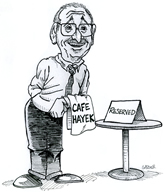It wasn’t surprising to see complaints about the agreement from labor groups and other economic isolationists. But large business organizations emphasized the gains it has produced for Americans. The Business Roundtable, a group of over 200 CEOs, noted that “trade with Canada and Mexico supports 13 million American jobs today.” Since July 2020, “Canada and Mexico have invested $775 billion in the United States and there has been a 50 percent increase in two-way trade, totaling $1.9 trillion in goods and services.” The group pointed out that “all three countries have experienced steady economic growth, but the United States has grown faster than Canada and Mexico.”
The U.S. Chamber of Commerce commented that U.S. producers “export more made-in-America manufactured goods to our North American neighbors than they do to the next 12 largest export markets combined, and the two countries purchase one-third of all U.S. agricultural exports.” In a separate Nov. 12 document, the National Association of Manufacturers called the USMCA “the most pro-U.S. manufacturing trade agreement in history.” It has also called the USMCA “a core driver of the global competitiveness of manufacturers in the U.S.”
Tariffs are meant to reduce imports, and it seems that tariffs on toys are having that effect. Total U.S. toy imports fell by 31 percent in June 2025 compared to the same month a year earlier, after a year-over-year drop of 28 percent during May, according to data from The Toy Association.
The tariffs are affecting toys from other countries, too. Nintendo, the Japanese video game maker, announced in August that it would raise the price of its Switch gaming console by 15 percent in the United States. Officially, Nintendo said it was responding to “market conditions,” but the decision was seemingly in response to the Trump administration slapping 15 percent tariffs on Japanese imports. (Trump has also imposed a 20 percent tariff on imports from Vietnam, where Nintendo does much of its manufacturing.)
Eric Boehm explains that Trump’s grinchly tariffs are likely to raise the prices of toys. A slice:
Thanks to higher tariffs and other disruptions to global trade, some toys might be more expensive this holiday season. Others might be in short supply, and those that arrive from foreign countries by mail could come with a surprise nastier than a stocking full of coal: an expensive tax bill from the U.S. government.
To the average toy buyer, higher costs are the most visible impact of President Donald Trump’s tariffs, which are taxes applied to goods that enter the United States. Imports from China, where many basic toys and games are made, are now subject to a 30 percent tariff. Unlike during Trump’s first term, when many toys and other basic household items were exempted from the higher tariffs on Chinese goods, there are no carve-outs this time.
Brad Hargreaves argues that “a 50-year mortgage would fix our housing problem.”
US District Judge James Boasberg’s decision not to force Meta to divest Instagram and WhatsApp fits a broader pattern of American legal reasoning. Whatever Meta once was, the court said, it now competes directly with YouTube and TikTok in the booming short-video market. When TikTok was banned in India and briefly in the United States, users simply flowed to Meta’s apps instead. In a sector where consumer habits flip every few years and product categories blur, “personal social networking” is no longer a meaningful boundary.
For aspirational trustbusters, such mercurial consumer behavior highlights their inability to grapple with economic dynamism—the Schumpeterian churn in which new firms rise, old advantages erode, and incumbents survive only by reinventing themselves. Silicon Valley isn’t a landscape dotted with durable, fat-and-happy monopolies resting on turn-of-the-century laurels. Rather, it’s a perpetual-motion machine of copying, leapfrogging, and panic-driven launches of new features and functionality. And AI is scrambling the supposedly immutable hierarchy of “forever companies” again. Business innovation, not government intervention, is doing most of the competitive heavy lifting.
That dynamism also undermines the antitrust movement’s narrative of stagnant “gatekeepers.” Apple and Amazon still face lawsuits, but they may benefit from the same time lag, with the latter’s trial scheduled for 2027. By that time, market definitions, user behavior, and technological architectures may look nothing like the ones regulators drafted into their complaints. As one scholar told The Washington Post, antitrust litigation moves like an ostrich while the market races like Formula One. And if that’s the case, now add an artificial-intelligence jet engine to the F1 speedster.
Nicholas Kristof tweets about evil ICE agents: (HT Scott Lincicome)
In rural Yamhill County, Oregon, ICE agents seized a 17-year-old boy during his lunch break at McMinnville High School. They reportedly smashed a car window, with the broken glass injuring another student, dragged the boy out and took him to a detention center in Portland, an hour away — and then discovered that he was a US citizen, as he had said all along. The family has started a fundraiser for legal expenses.



